第一种方法是使用循环语句逐个将数据项插入到数据库中;第二种方法使用的是SqlBulkCopy,使您可以用其他源的数据有效批量加载 SQL Server 表;第三种使用的方法是sql server中的表值参数方法,表值参数是 SQL Server 2008 中的新参数类型。表值参数是使用用户定义的表类型来声明的。使用表值参数,可以不必创建临时表或许多参数,即可向 Transact-SQL 语句或例程(如存储过程或函数)发送多行数据。
代码示例:
此例子为控制台输出程序,有两个类,一个为BulkData类,主要实现了表值参数和sqlbulkcopy是如何插入数据的,一个类为Repository,一个app.config配置文件。所用数据库为sql server 2012。
建库语句:
--Create DataBase use master go if exists(select * from master.sys.sysdatabases where name=N'BulkDB') drop database BulkDB create database BulkDB; go --Create Table use BulkDB go if exists(select * from sys.objects where object_id=OBJECT_ID(N'[dbo].[BulkTable]') and type in(N'U')) drop table [dbo].BulkTable Create table BulkTable( Id int primary key, UserName nvarchar(32), Pwd varchar(16)) go --Create Table Valued use BulkDB go if exists ( select * from sys.types st join sys.schemas ss on st.schema_id=ss.schema_id where st.name=N'[BulkType]' and ss.name=N'dbo' ) drop type [dbo].[BulkType] go create type [dbo].[BulkType] as table ( Id int, UserName nvarchar(32), Pwd varchar(16) ) go select * from dbo.BulkTable BulkData.cs
using System;
using System.Collections.Generic;
using System.Linq;
using System.Text;
using System.Data;
using System.Data.SqlClient;
using System.Configuration;
namespace BulkData
{
class BulkData
{
public static void TableValuedToDB(DataTable dt)
{
SqlConnection sqlConn = new SqlConnection(
ConfigurationManager.ConnectionStrings["ConnStr"].ConnectionString);
const string TSqlStatement =
"insert into BulkTable (Id,UserName,Pwd)"
" SELECT nc.Id, nc.UserName,nc.Pwd"
" FROM @NewBulkTestTvp AS nc";
SqlCommand cmd = new SqlCommand(TSqlStatement, sqlConn);
SqlParameter catParam = cmd.Parameters.AddWithValue("@NewBulkTestTvp", dt);
catParam.SqlDbType = SqlDbType.Structured;
catParam.TypeName = "dbo.BulkType";
try
{
sqlConn.Open();
if (dt != null && dt.Rows.Count != 0)
{
cmd.ExecuteNonQuery();
}
}
catch (Exception ex)
{
throw ex;
}
finally
{
sqlConn.Close();
}
}
public static DataTable GetTable()
{
DataTable dt = new DataTable();
dt.Columns.AddRange(new DataColumn[]{new DataColumn("Id",typeof(int)),new DataColumn("UserName",typeof(string)),new DataColumn("Pwd",typeof(string))});
return dt;
}
public static void BulkToDB(DataTable dt)
{
SqlConnection sqlConn = new SqlConnection(ConfigurationManager.ConnectionStrings["ConnStr"].ConnectionString);
SqlBulkCopy bulkCopy = new SqlBulkCopy(sqlConn);
bulkCopy.DestinationTableName = "BulkTable";
bulkCopy.BatchSize = dt.Rows.Count;
try
{
sqlConn.Open();
if (dt != null && dt.Rows.Count != 0)
bulkCopy.WriteToServer(dt);
}
catch (Exception ex)
{
throw ex;
}
finally
{
sqlConn.Close();
if (bulkCopy != null)
bulkCopy.Close();
}
}
}
}
Repository.cs
using System;
using System.Collections.Generic;
using System.Linq;
using System.Text;
using System.Data;
using System.Data.SqlClient;
using System.Configuration;
using System.Diagnostics;
namespace BulkData
{
public class Repository
{
public static void UseSqlBulkCopyClass()
{
Stopwatch sw = new Stopwatch();
for (int outLayer = 0; outLayer < 10; outLayer )
{
DataTable dt = BulkData.GetTable();
for (int count = outLayer * 100000; count < (outLayer 1) * 100000; count )
{
DataRow r = dt.NewRow();
r[0] = count;
r[1] = string.Format("User-{0}", count * outLayer);
r[2] = string.Format("Password-{0}", count * outLayer);
dt.Rows.Add(r);
}
sw.Start();
BulkData.BulkToDB(dt);
sw.Stop();
Console.WriteLine(string.Format("{1} hundred thousand data elapsed Time is {0} Milliseconds", sw.ElapsedMilliseconds, outLayer 1));
}
Console.ReadLine();
}
public static void UseTableValue()
{
Stopwatch sw = new Stopwatch();
for (int outLayer = 0; outLayer < 10; outLayer )
{
DataTable dt = BulkData.GetTable();
for (int count = outLayer * 100000; count < (outLayer 1) * 100000; count )
{
DataRow dataRow = dt.NewRow();
dataRow[0] = count;
dataRow[1] = string.Format("User-{0}", count * outLayer);
dataRow[2] = string.Format("Password-{0}", count * outLayer);
dt.Rows.Add(dataRow);
}
sw.Start();
BulkData.TableValuedToDB(dt);
sw.Stop();
Console.WriteLine(string.Format("{1} hundred thousand data elapsed Time is {0} Milliseconds", sw.ElapsedMilliseconds, outLayer 1));
}
Console.ReadLine();
}
public static void UserNormalInsert()
{
Stopwatch sw = new Stopwatch();
SqlConnection sqlConn = new SqlConnection(ConfigurationManager.ConnectionStrings["ConnStr"].ConnectionString);
SqlCommand sqlComm = new SqlCommand();
sqlComm.CommandText = string.Format("insert into BulkTable(Id,UserName,Pwd)values(@p0,@p1,@p2)");
sqlComm.Parameters.Add("@p0", SqlDbType.Int);
sqlComm.Parameters.Add("@p1", SqlDbType.NVarChar);
sqlComm.Parameters.Add("@p2", SqlDbType.VarChar);
sqlComm.CommandType = CommandType.Text;
sqlComm.Connection = sqlConn;
sqlConn.Open();
try
{
for (int outLayer = 0; outLayer < 10; outLayer )
{
for (int count = outLayer * 100000; count < (outLayer 1) * 100000; count )
{
sqlComm.Parameters["@p0"].Value = count;
sqlComm.Parameters["@p1"].Value = string.Format("User-{0}", count * outLayer);
sqlComm.Parameters["@p2"].Value = string.Format("Password-{0}", count * outLayer);
sw.Start();
sqlComm.ExecuteNonQuery();
sw.Stop();
}
Console.WriteLine(string.Format("{1} hundred thousand data elapsed Time is {0} Milliseconds", sw.ElapsedMilliseconds, outLayer 1));
}
}
catch (Exception ex)
{
throw ex;
}
finally
{
sqlConn.Close();
}
Console.ReadLine();
}
}
}
App.config
connectionString="data source=.;Integrated Security=SSPI;Initial Catalog=BulkDB" providerName="System.Data.SqlClient" /> Program.cs
using System;
using System.Collections.Generic;
using System.Linq;
using System.Text;
using System.Data;
using System.Data.SqlClient;
using System.Configuration;
using System.Diagnostics;
namespace BulkData
{
class Program
{
static void Main(string[] args)
{
//Repository.UseSqlBulkCopyClass();
Repository.UseTableValue();
//Repository.UserNormalInsert();
}
}
}
三种方法分别插入100万条数据所用的时间为:
循环语句所用时间:
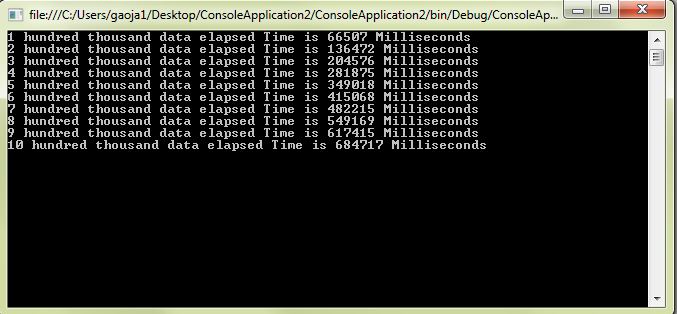
sqlbulkcopy方法所用时间为:
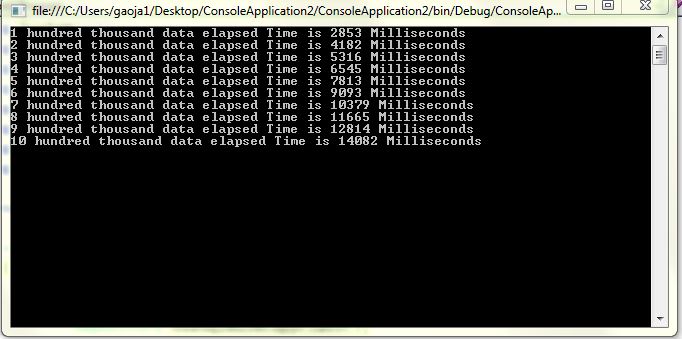
表值参数所用时间为:
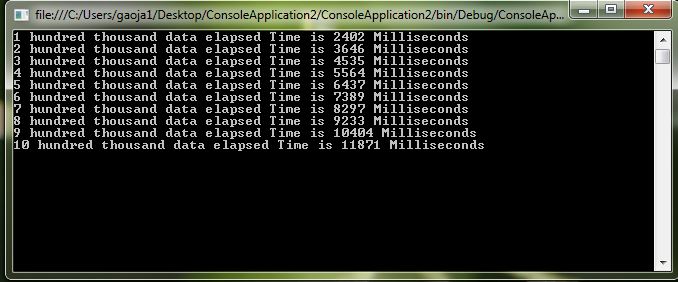
我不会告诉你有一种sql语法可以这么写:
insert into SystemSet_tbl (ss_guid,ss_type,ss_comment) values ('00000000-0000-0000-0000-000000000007',1,''),('00000000-0000-0000-0000-000000000008',1,'')
© 版权声明
本文刊载的所有内容,包括文字、图片、音频、视频、软件、程序、以及网页版式设计等部门来源于互联网,版权均归原作者所有!本网站提供的内容服务于个人学习、研究或欣赏,以及其他非商业性或非盈利性用途,但同时应遵守著作权法及其他相关法律的规定,不得侵犯本网站及相关权利人的合法权利。
联系信息:邮箱aoxolcom@163.com或见网站底部。
联系信息:邮箱aoxolcom@163.com或见网站底部。
THE END



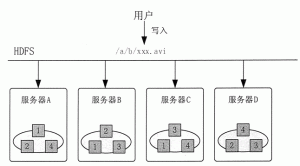

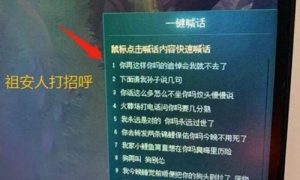
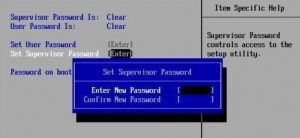
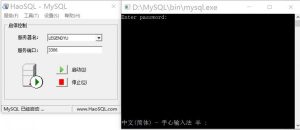
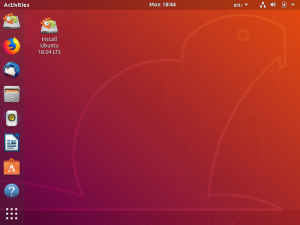
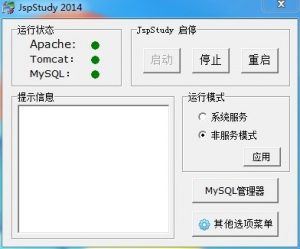


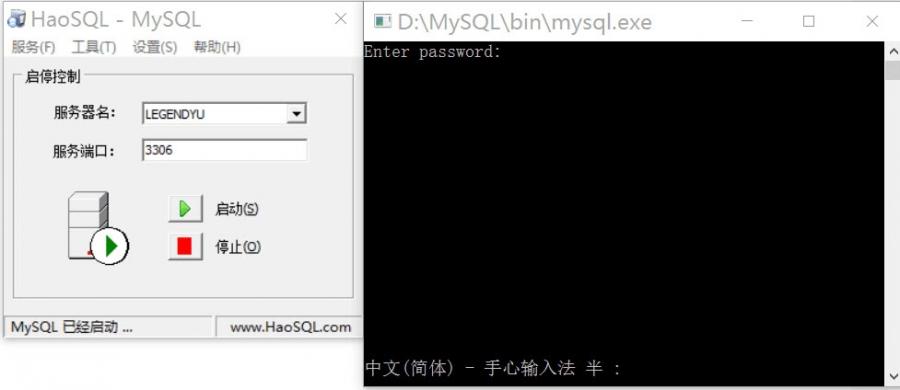


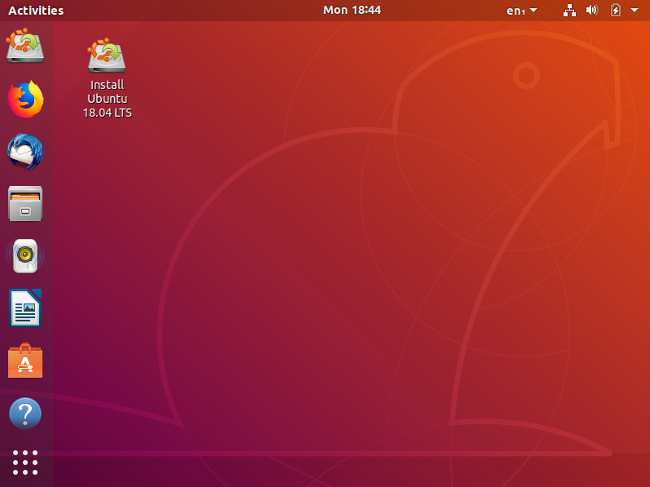



请登录后发表评论
注册
社交帐号登录